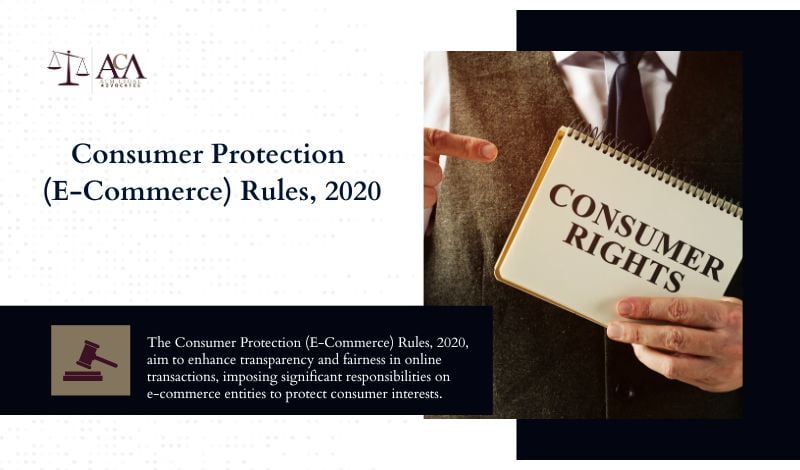How do we ensure that consumer rights are protected amidst the convenience and vast selection of e-commerce? With the surge in e-commerce, protecting consumer rights online has become crucial.
Enter the Consumer Protection (E-Commerce) Rules, 2020, a set of regulations designed to make online shopping safer and more reliable. These rules ensure that e-commerce platforms are transparent about prices, return policies and seller details, aiming to build trust in online transactions.
As we explore the protective measures laid out by these rules, it is important to first understand the backdrop against which they were formulated.
Background of the E-Commerce Rules
With the digital marketplace booming, India saw a pressing need to regulate e-commerce to protect consumers. The Consumer Protection (E-Commerce) Rules, 2020, introduced by the Ministry of Consumer Affairs, Food, and Public Distribution in India, were introduced against a backdrop of rising online fraud, lack of transparency and unfair trade practices in the rapidly growing e-commerce sector.
For instance, consumers frequently encountered situations where electronic gadgets purchased online were counterfeit or of inferior quality and opaque policies often hindered their ability to return unsatisfactory products.
These rules aim to create a safer and more transparent online shopping environment and advocate for effective grievance redressal mechanisms and hold e-commerce entities accountable for counterfeit or fraudulent products sold on their platforms.
Evolution of E-Commerce
E-commerce in India has seen a significant surge, recording a 26.2% year-over-year order volume growth in FY 2023 [1]. Its evolution from the late 1990s to becoming a global powerhouse has reshaped consumer interaction with markets. This digital revolution has made shopping more convenient, offering a wider range of products and services with the click of a button.
However, the rise of e-commerce also brought forth significant implications for consumer rights, including the anonymous nature of transactions, difficulties in verifying product authenticity, data privacy concerns and the challenge of addressing cross-border disputes.
Recognizing these challenges, the Indian government has taken significant steps to enhance consumer protection in the e-commerce landscape.
- The country’s internet penetration reached over 880 million as of March 2023, supported by an extensive telecom subscriber base of over 1172 million. This digital adoption is propelled by increased smartphone penetration, affordable data prices, and a rising affluent consumer base.
- Impressively, nearly 100% of pin codes in India have seen e-commerce adoption, with more than 60% of transactions and orders coming from tier two cities and smaller towns, highlighting the widespread acceptance and reliance on e-commerce across diverse geographies. [2]
- To directly address the evolving landscape of e-commerce and its implications for consumer protection, the Indian government has implemented regulations requiring online marketplaces to disclose complete details about sellers, product authenticity and return policies. This move ensures transparency and accountability, essential for protecting consumers across India’s vast online marketplace.
Purpose of the Rules
The objectives of the 2020 E-Commerce Rules, designed to protect online consumers, include:
a. Enhance Transparency
Mandate e-commerce platforms to disclose detailed information about sellers, return and refund policies and terms of service to ensure consumers make informed decisions.
b. Prevent Unfair Trade Practices
Prohibit misleading advertisements, fake reviews and undisclosed promotion charges to maintain fair competition and consumer trust.
c. Safeguard Consumer Interests
Introduce regulations against the sale of counterfeit products and ensure that goods and services meet the advertised standards.
d. Establish Accountability
E-commerce entities are required to appoint a Grievance Officer for consumer grievance redressal, ensuring consumer complaints are addressed promptly.
e. Promote Fair Contract Terms
Prevent e-commerce platforms from imposing unfair contract terms on consumers, ensuring a balanced and equitable buyer-seller relationship.
f. Data Protection
Emphasize the importance of protecting consumer data collected by e-commerce platforms, reinforcing privacy and security standards.
g. Regulate E-commerce Marketplace
Provide a clear definition and distinction between marketplace and inventory-based e-commerce models.
h. Global Standards Compliance
Align India’s e-commerce consumer protection framework with international best practices, addressing the cross-border nature of digital commerce.
Key Provisions of the E-Commerce Rules
The Consumer Protection (E-Commerce) Rules, 2020, aim to protect the interests of consumers engaging in digital transactions. Here are the key provisions outlined in these rules:
1. Transparency Requirements
E-commerce entities must provide clear information about the seller, return, refund, exchange policies, delivery and shipment details, payment methods and grievance redressal mechanisms.
2. Liabilities of Marketplace E-commerce Entities
The descriptions of goods and services listed should be accurate and include a contractual undertaking with sellers to guarantee the authenticity of products sold.
3. Prohibition on Unfair Trade Practices
Sellers are prohibited from adopting unfair trade practices, posting fake reviews or refusing to take back goods or withdraw services if they are deficient. Rules specify conditions under which a return of goods can be requested by consumers, ensuring a straightforward and consumer-friendly return process.
They are required to provide a mechanism for consumers to differentiate between ads and organic search results on their platforms. The rules forbid e-commerce entities from manipulating search results or product listings in a way that leads to biased or misleading representation.
They must also not manipulate the price of the goods or services offered to gain unreasonable profit.
4. Grievance Redressal
E-commerce platforms are mandated to establish an efficient grievance redressal mechanism. They must appoint a grievance officer who shall redress consumer complaints within one month of receiving the complaint.
5. Consent
Platforms must ensure that consent for purchase is explicitly obtained from the consumer and cannot record consent automatically, including in the form of pre-ticked checkboxes.
Implementation and Enforcement
The Consumer Protection (E-Commerce) Rules, 2020, under the purview of the Department of Consumer Affairs, Ministry of Consumer Affairs, Food and Public Distribution, Government of India, set forth a comprehensive framework aimed at regulating e-commerce entities.
Role of E-Commerce Platforms
E-commerce platforms are required to establish an internal compliance mechanism, including the appointment of a grievance officer to address consumer complaints. The platforms are mandated to display the name, contact details, and designation of the grievance officer prominently on their websites.
E-commerce entities are mandated to ensure that personally identifiable information of consumers is protected and not disclosed without their consent.
Compliance Mechanisms
The Central Consumer Protection Authority (CCPA), established under the Consumer Protection Act, 2019, plays a crucial role in overseeing the enforcement of these rules. The CCPA is empowered to investigate violations of consumer rights and unfair trade practices, issue safety notices for goods and services and direct the discontinuation of certain practices and advertisements harmful to consumer interests.
The government’s approach toward implementing these rules involves continuous monitoring, evaluation and engagement with stakeholders, including consumers, e-commerce companies and industry associations.
The Department of Consumer Affairs‘ official website provides detailed information and updates regarding the rules and their enforcement, acting as a central resource for consumers and e-commerce entities alike to understand their rights and obligations under the Consumer Protection (E-Commerce) Rules, 2020.
Case Study
The Consumer Protection (E-Commerce) Rules, 2020, have sparked discussions about how they are put into action. A key part of these rules is the idea of “fall-back liability.” This concept makes online marketplaces more responsible.
It says that if a seller on their site doesn’t meet their duties to the buyer, causing the buyer to lose out, then the marketplace might be held responsible.
Facts of the Case
An important legal case involving Amazon India shows how e-commerce platforms were viewed before these rules came into effect. The Chhattisgarh State Consumer Redressal Commission ruled that Amazon India was only helping out and couldn’t be blamed for what sellers did on its site.
This ruling supported the old view that e-commerce sites, as middlemen, weren’t directly accountable for their sellers’ actions.A noteworthy case that sheds light on the judicial stance regarding the liabilities of e-commerce platforms before the enforcement of these rules involved Amazon India.
The Chhattisgarh State Consumer Redressal Commission ruled in favour of Amazon India, stating it acted merely as a facilitator and thus could not be held responsible for the actions of sellers on its platform.
This decision highlighted the traditional view that e-commerce platforms, functioning as intermediaries, were not directly liable for the sellers’ actions.
Impact Analysis
The introduction of the “fall-back liability” clause aims to correct the balance of power and shield buyers from being taken advantage of by online marketplaces and their sellers.
It’s important to note that, although these rules are designed to strengthen consumer protection, they also bring up concerns for e-commerce sites. They also raise concerns about how these e-commerce platforms will handle these bigger responsibilities, especially smaller sites and new companies.
Challenges and Critiques
Although the Consumer Protection (E-Commerce) Rules, 2020, represent a significant step towards regulating online marketplaces, like any regulatory framework, they come with their set of challenges and limitations that highlight areas for potential improvement.
Limitations
a. One-Size-Fits-All Approach
The rules adopt a broad approach that may not suit the diverse nature of e-commerce businesses, particularly affecting small and medium-sized enterprises (SMEs) due to the compliance burden.
b. Increased Operational Costs for SMEs
The obligation to appoint a grievance officer may impose significant operational costs on smaller e-commerce platforms.
c. Vagueness and Ambiguities
Some provisions, such as those related to “fall-back liability” and what constitutes “unfair trade practices,” have been flagged for their vagueness, leading to legal uncertainties.
d. Global Compliance Challenges
For international e-commerce entities, aligning with these rules while managing compliance with their home country’s regulations can be complex.
Suggestions for Improvement
a. Differentiated Compliance Mechanism
Introducing a tiered compliance mechanism based on the size and turnover of e-commerce entities could make the rules more adaptable.
b.Clearer Definitions
Providing more precise definitions for terms like “unfair trade practices” and outlining specific examples could help reduce ambiguities.
c. Strengthening Consumer Awareness
Alongside regulatory measures, there should be an emphasis on educating consumers about their rights and how to exercise them effectively.
d. Feedback Loop
Establishing a mechanism for regular feedback from both consumers and e-commerce platforms can help in continuously refining the rules.
Frequently Asked Questions
1. What are the main consumer rights protected under the E-Commerce Rules, 2020?
The E-Commerce Rules, 2020, protect several consumer rights, including:
- the right to information (about goods and services, seller details, and the grievance officer),
- the right to transparent return, refund and exchange policies, and
- the right against unfair trade practices.
2. How do these rules ensure transparency in online transactions?
These rules ensure transparency by mandating e-commerce platforms to disclose details about the seller, product, price, return, refund and exchange policies, ensuring consumers have all necessary information before making a purchase.
3. What should consumers do if they have a grievance against an E-commerce platform?
Consumers should first contact the grievance officer of the e-commerce platform. If the issue is not resolved satisfactorily, they can lodge a complaint with the Consumer Protection Authority or approach consumer courts.
4. Are there specific rules for product returns and refunds in e-commerce?
Yes, the E-Commerce Rules require platforms to clearly state their return and refund policies, ensuring that consumers are aware of the terms before purchasing. These policies must be reasonable and transparent.
5. How do the E-Commerce Rules, 2020, address unfair trade practices online?
The rules prohibit misleading advertisements, fake reviews and undisclosed charges, among other unfair trade practices, protecting consumers from deceptive behaviours by e-commerce entities.
6. What responsibilities do e-commerce platforms have under these rules?
E-commerce platforms are responsible for:
- Ensuring transparency
- Appointing a grievance officer
- Displaying clear terms and conditions, including return and refund policies, and
- Preventing unfair trade practices on their platforms.
7. How can consumers ensure their rights are protected when shopping online?
- Educate Yourself: Know your rights under the Consumer Protection Act, 2019, and the E-Commerce Rules, 2020.
- Verify the Platform: Shop from reputable and well-known e-commerce platforms
- Read Policies: Before making a purchase, read the platform’s return, refund, and privacy policies.
- Secure Payments: Use secure payment methods.
- Keep Records: Save all transaction details, including communication with the seller and receipts.
- Use Grievance Redressal Mechanisms: If you encounter issues, use the platform’s grievance redressal mechanism. If unresolved, you can approach consumer protection forums.
8. What are the penalties for e-commerce platforms that violate these rules?
E-commerce platforms that fail to comply with the Consumer Protection (E-Commerce) Rules, 2020, can face penalties under the Consumer Protection Act, 2019. These penalties may include fines and imprisonment for the individuals responsible. The Act provides for penalties for misleading advertisements, selling counterfeit products, not adhering to the prescribed return and refund policies and other violations that harm consumer interests.
9. Do these rules apply to international e-commerce transactions?
Yes, the Consumer Protection (E-Commerce) Rules, 2020, apply to all e-commerce transactions involving the buying or selling of goods or services to consumers in India, regardless of whether the e-commerce entity is based in India or operates from outside India.
10. How have the E-Commerce Rules, 2020, impacted the online marketplace?
The Consumer Protection (E-Commerce) Rules, 2020, have enhanced transparency, accountability and consumer protection. These rules have prompted e-commerce platforms to revise their policies and practices to ensure compliance, leading to a safer and more reliable online shopping environment for consumers. While the rules have increased operational compliance requirements for e-commerce entities, they have also contributed to building consumer trust in online transactions.
Final Thoughts
The Consumer Protection (E-Commerce) Rules, 2020, have set a new benchmark for consumer protection in India’s e-commerce sector. By emphasizing transparency, grievance redressal and fair trade practices, these rules aim to build a trustworthy online marketplace for consumers.
As the e-commerce landscape continues to evolve, the effectiveness of these rules will depend on their adaptability and the collective effort of all stakeholders to uphold the principles of consumer protection.
The journey towards a fully compliant and consumer-friendly e-commerce environment is ongoing, and these rules serve as a foundational step in that direction.
Navigate E-Commerce with Confidence and Knowledge
In the rapidly evolving digital marketplace, being informed and aware of your consumer rights is more crucial than ever.
Remember, as an e-commerce consumer, you’re not alone. Resources and support are available to help you uphold your rights and ensure a fair, transparent and satisfying online shopping experience.





